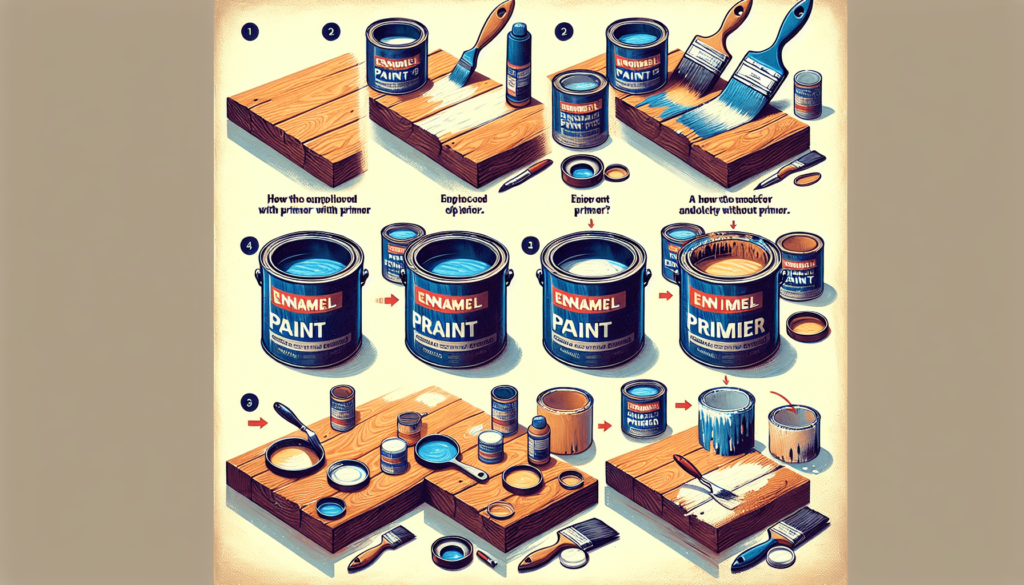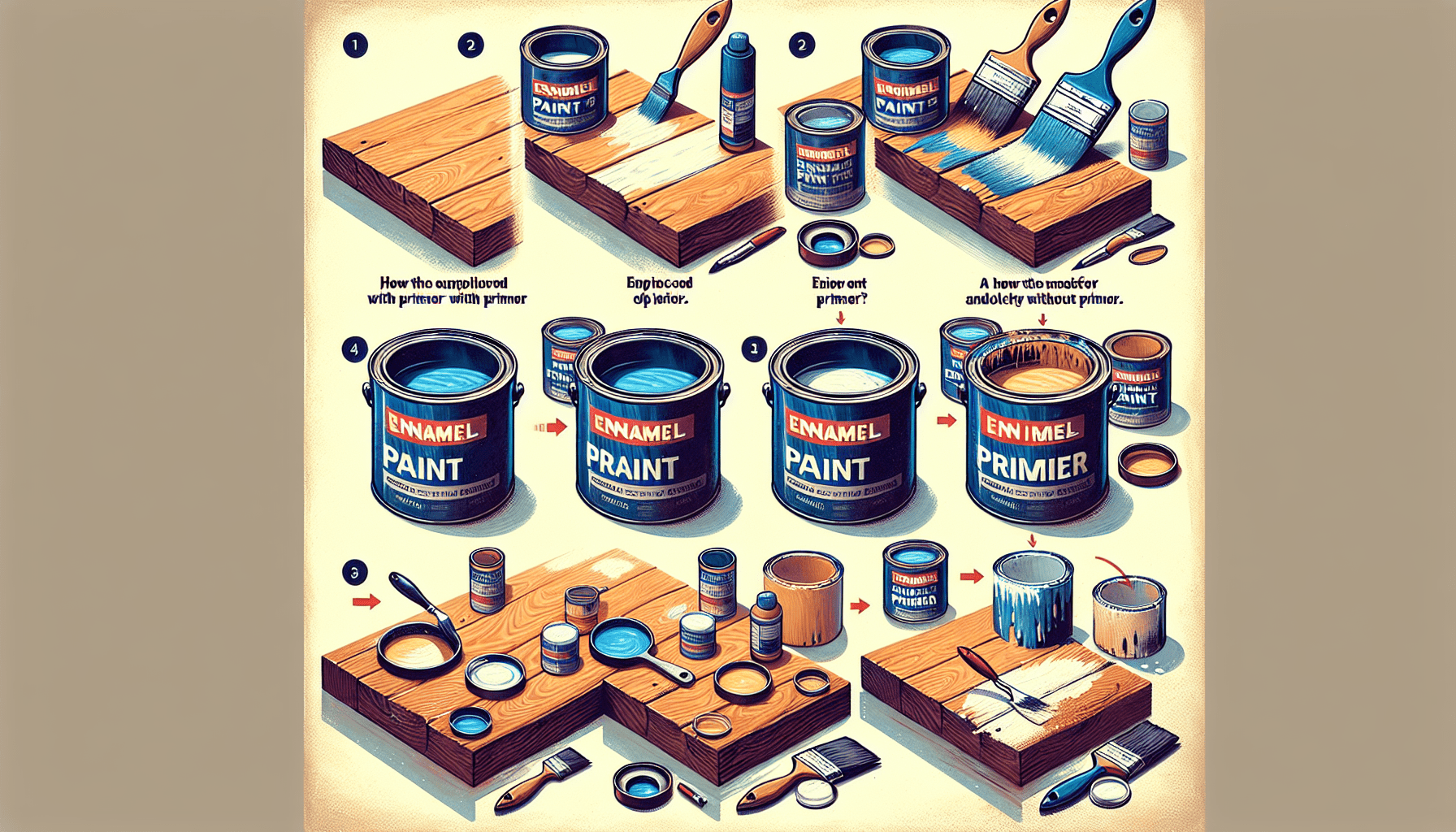Enamel paint is a popular choice for many surfaces due to its durability and glossy finish. However, one common question that arises is whether enamel paint requires a primer before application. This article will explore the importance of primer when using enamel paint, outlining the benefits it brings and the potential consequences of skipping this crucial step. By understanding the role of primer in the application of enamel paint, you can ensure a professional and long-lasting finish for your painting projects.

What is enamel paint?
Definition of enamel paint
Enamel paint is a type of paint that is known for its hard, smooth, and glossy finish. It is commonly used for painting surfaces such as metal, wood, and ceramics. Enamel paint is made up of a pigment, a binder, and a solvent. The pigment provides color, the binder holds the pigment together, and the solvent allows the paint to be applied smoothly. Enamel paint is available in both oil-based and water-based formulas, offering different application and drying characteristics.
Characteristics of enamel paint
Enamel paint is known for its several key characteristics that set it apart from other types of paint. Firstly, it provides a durable and long-lasting finish that can withstand wear and tear. This makes it suitable for high-traffic areas and surfaces that are exposed to harsh environmental conditions. Secondly, enamel paint has excellent adhesion properties, allowing it to bond tightly to the surface it is applied to. This contributes to its durability and ensures a smooth and uniform finish. Lastly, enamel paint dries to a glossy finish, giving a professional and polished appearance to any painted surface.
What is primer?
Definition of primer
Primer is a preparatory coating that is applied before the application of enamel paint. It serves as a bonding layer between the surface and the paint, enhancing the adhesion and durability of the paint. Primer is typically a lighter shade than the final paint color, allowing it to act as a base or foundation for the paint to adhere to. It is available in various formulas, such as oil-based, water-based, and shellac-based, to suit different surface types and paint requirements.
Purpose of primer
The main purpose of using primer is to create an ideal surface for the enamel paint to adhere to. Primer helps to seal the surface, making it less porous and providing a smoother and more uniform base. It also helps to block stains and discolorations, ensuring that the final paint color appears true and vibrant. In addition, primer can improve the coverage of the paint, reducing the number of coats required for a satisfactory finish. Overall, primer plays a crucial role in the longevity and aesthetic appeal of the painted surface.
The role of primer in painting
Improves adhesion
One of the primary benefits of using primer before applying enamel paint is its ability to enhance adhesion. Primer creates a strong bond between the surface and the paint, preventing peeling, cracking, and flaking. By providing a stable foundation, primer ensures that the paint adheres evenly and securely to the surface, even in challenging conditions. This is particularly important when painting surfaces that are prone to moisture, temperature variations, or frequent contact.
Enhances paint durability
Primer acts as a protective barrier, enhancing the durability and longevity of the enamel paint. It seals the surface, preventing moisture, chemicals, and other external factors from compromising the paint’s integrity. Primer also helps to resist fading caused by exposure to sunlight, ensuring that the color remains vibrant for a longer period. By strengthening the adhesion of the paint, primer reduces the risk of chipping and peeling, thereby extending the lifespan of the painted surface.
Reduces coats of paint needed
Using primer can significantly reduce the number of coats of enamel paint needed to achieve satisfactory coverage. The primer creates a smooth and even surface, minimizing the absorption of the paint and allowing it to spread more evenly. This means that fewer coats of paint are required to achieve a solid and consistent color. By reducing the amount of paint needed, primer not only saves time and effort but also reduces costs associated with purchasing and applying multiple coats of paint.
Provides a uniform surface
Another advantage of using primer is its ability to provide a uniform surface for the enamel paint. Primer fills in any imperfections in the surface, such as cracks, holes, or uneven texture, creating a smooth and level base. This ensures that the final paint finish appears consistent and professional. Without primer, the paint may highlight surface irregularities or adhere unevenly, resulting in an unattractive and bumpy appearance. Primer acts as a buffer, allowing the paint to glide smoothly and evenly over the surface, yielding a flawless finish.
Prevents stains and discoloration
Primer helps to block stains and discolorations that may show through the enamel paint. It creates a barrier that prevents substances, such as water, grease, or tannins, from penetrating the paint and causing unsightly spots or color changes. By sealing the surface, primer ensures that the final paint color remains true and unaffected by underlying substances. This is particularly important when painting over surfaces with a history of stains or when applying light-colored enamel paint that is prone to showing discolorations.
Enamel paint without primer
Painting on porous surfaces
While using primer is highly recommended for most enamel paint applications, there are certain situations where it may be possible to skip this step. For example, when painting on non-porous surfaces, such as metal or glass, where adhesion is not a concern, primer may not be necessary. Enamel paint has inherent adhesive properties that allow it to bond well with these types of surfaces, eliminating the need for an additional layer of primer.
Potential adhesion issues
When enamel paint is applied directly to a porous surface without primer, there is a risk of poor adhesion. Porous surfaces, such as wood or masonry, have crevices and inconsistencies that can hinder the paint’s ability to bond effectively. As a result, the paint may not adhere evenly or securely, leading to peeling, cracking, or flaking over time. To ensure optimal adhesion and longevity, it is recommended to use primer before applying enamel paint, especially on porous surfaces.
Faster drying time
Enamel paint without primer may have a faster drying time compared to when primer is used. This is because primer absorbs moisture and slows down the drying process of the paint. While faster drying time may be desirable in some cases, it can also make it challenging to achieve a smooth and even finish. Primer provides a slower drying time, allowing the paint to level out and self-correct, resulting in a more professional-looking final result.
Less durability
By skipping the primer step, the durability of the enamel paint may be compromised. Primer acts as a protective barrier, preventing moisture, chemicals, and other external factors from damaging the paint. Without primer, the paint may be more susceptible to chips, scratches, and fading, especially on surfaces exposed to harsh conditions. To ensure maximum durability and longevity, it is advised to use primer before applying enamel paint.
More coats of paint required
When enamel paint is applied without primer, it may require more coats to achieve satisfactory coverage. Without the barrier provided by primer, the paint can be absorbed more readily into the surface, resulting in a patchy or uneven finish. Multiple coats of paint may be needed to compensate for the lack of primer and ensure a solid and consistent color. This can prolong the painting process and increase the amount of paint required.
Possible appearance issues
Applying enamel paint without primer may lead to potential appearance issues. This is especially true when painting over surfaces with existing stains, discolorations, or imperfections. Primer helps to block these surface irregularities and create a smooth and uniform base for the paint. Without primer, the paint may highlight underlying imperfections, resulting in an unattractive and flawed finish. To achieve a professional-looking appearance, it is best to use primer before applying enamel paint.

When is primer not necessary for enamel paint?
Painting on non-porous surfaces
For non-porous surfaces, such as metal or glass, primer may not be necessary when using enamel paint. These surfaces do not absorb the paint like porous surfaces do, allowing the enamel paint to adhere effectively on its own. However, it is still recommended to clean and prepare the surface properly before applying the paint to ensure optimal adhesion and longevity.
Using self-priming enamel paint
Some enamel paints are specifically formulated to be self-priming, meaning they contain properties that eliminate the need for a separate primer. These self-priming enamel paints are designed to bond well with various surfaces without the additional step of using primer. However, it is important to read the manufacturer’s instructions to determine if the specific self-priming enamel paint is suitable for the intended surface and application.
Painting over existing enamel paint
When painting over an existing layer of enamel paint with the same type of enamel paint, primer may not be necessary. Enamel paint has excellent adhesion properties and can bond well with previously painted surfaces. However, it is still important to clean and lightly sand the surface to ensure proper adhesion and a smooth finish.
Painting small projects or decorative items
For small projects or decorative items where adhesion and durability are not of utmost importance, primer may be optional. These types of projects often involve less wear and tear or exposure to harsh conditions. However, using primer can still enhance the overall finish and longevity of the paint, so it may be beneficial even for small projects.
Types of enamel paint
Oil-based enamel paint
Oil-based enamel paint is a traditional and durable type of enamel paint that has been used for many years. It provides a hard and glossy finish, making it suitable for high-traffic areas and surfaces that require extra protection. Oil-based enamel paint has a longer drying time compared to water-based enamel paint, allowing for better self-leveling and a smoother finish. However, it also has a stronger odor and requires mineral spirits or turpentine for cleanup.
Water-based enamel paint
Water-based enamel paint, also known as latex enamel paint, is a more environmentally friendly alternative to oil-based enamel paint. It dries faster and has a lower odor, making it easier to work with. Water-based enamel paint is suitable for both interior and exterior applications and can be cleaned up with soap and water. However, it may not provide the same level of durability and hardness as oil-based enamel paint.
Different types of primers
Oil-based primer
Oil-based primer is a versatile primer that can be used on various surfaces, including wood, metal, and masonry. It provides excellent adhesion and sealing properties, making it suitable for both interior and exterior applications. Oil-based primer has a longer drying time compared to other types of primers, allowing for better leveling and coverage. However, it requires mineral spirits or turpentine for cleanup.
Water-based primer
Water-based primer, also known as latex primer, is a popular choice for interior applications. It is easy to use, dries quickly, and has a lower odor compared to oil-based primer. Water-based primer is suitable for use on surfaces such as drywall, wood, and previously painted walls. It can be cleaned up with soap and water, making it more convenient for everyday use.
Shellac-based primer
Shellac-based primer is a versatile primer that can be used on various surfaces, including wood, metal, and even on difficult substrates such as knots or stains. It provides excellent stain-blocking properties and has good adhesion to most surfaces. Shellac-based primer dries quickly and can be recoated in a short amount of time. However, it has a strong odor and requires denatured alcohol for cleanup.
Specialty primers
In addition to the common types of primers mentioned above, there are also specialty primers available for specific requirements. This includes primers designed for use on bare metal, rusted surfaces, stains, or surfaces prone to bleed-through. These specialty primers are formulated to address specific issues and provide optimal adhesion and coverage for challenging surfaces.
How to properly apply primer and enamel paint
Surface preparation
Before applying primer and enamel paint, proper surface preparation is essential. This includes cleaning the surface to remove any dirt, dust, grease, or other contaminants. Sanding may be required to smooth rough surfaces or remove any loose paint. For new or bare surfaces, it is important to prime the surface before applying enamel paint. The surface should be dry and free from moisture before proceeding with primer application.
Choosing the right primer
Selecting the appropriate primer is important for achieving optimal results. Consider the type of surface, the paint system being used, and any specific requirements such as stain-blocking or adhesion enhancement. Consult the manufacturer’s guidelines and recommendations to choose a primer that is compatible with the enamel paint and the surface being painted. Prioritize quality, as investing in a reliable primer can greatly impact the longevity and appearance of the painted surface.
Applying primer
When applying primer, follow the manufacturer’s instructions carefully. Use a brush, roller, or spray gun, depending on the size and complexity of the project. Apply the primer evenly and avoid leaving any drips or pooling. For large surfaces, working in small sections can help ensure proper coverage and avoid drying inconsistencies. Allow the primer to dry completely before proceeding with the next steps.
Drying time and sanding
After the primer has dried, it is important to check the manufacturer’s recommended drying time before proceeding with sanding. Sand the primed surface lightly using fine-grit sandpaper to create a smooth and even surface. This step helps to remove any imperfections, roughness, or brush marks left by the primer. Remove any dust or debris before proceeding to apply the enamel paint.
Applying enamel paint
When applying enamel paint, the process is similar to that of primer application. Follow the manufacturer’s instructions and use the appropriate tools for the project. Apply the paint evenly and avoid leaving brush marks or streaks. For large projects, consider working in small sections to maintain consistency and avoid drying issues. Allow the paint to dry completely before applying additional coats, if necessary.
Benefits of using primer with enamel paint
Improved paint adhesion
Using primer before applying enamel paint significantly improves the adhesion of the paint to the surface. Primer acts as a bonding layer, creating a strong and secure foundation for the paint to adhere to. This enhances the durability and longevity of the paint, preventing issues such as peeling, cracking, or flaking. By ensuring optimal adhesion, primer helps to create a more professional and long-lasting finish.
Enhanced durability
Primer provides a protective barrier that enhances the durability of the enamel paint. It seals the surface, preventing moisture, chemicals, and other external factors from compromising the paint’s integrity. This results in a paint finish that is more resistant to chipping, scratching, and fading. By improving the durability of the paint, primer helps to maintain the appearance and functionality of the painted surface over time.
Better paint coverage
Using primer reduces the number of coats of enamel paint needed to achieve satisfactory coverage. Primer creates a smooth and even base that minimizes the absorption of the paint and allows it to spread more evenly. This means that fewer coats of paint are required to achieve a solid and consistent color. By reducing the amount of paint needed, primer saves time, effort, and costs associated with purchasing and applying multiple coats of paint.
Professional-looking finish
Primer helps to create a uniform surface and improves the overall appearance of the enamel paint. By filling in imperfections and providing a smooth base, primer ensures that the final paint finish appears consistent and professional. It helps to minimize the appearance of surface irregularities and ensures that the paint adheres evenly, resulting in a flawless and polished look. Using primer contributes to a more aesthetically pleasing and higher-quality finish.
Conclusion
The use of primer in enamel paint applications is highly recommended for optimal results. Primer improves the adhesion, durability, and appearance of the paint, providing a solid foundation for the final finish. While there may be certain situations where primer can be skipped, such as painting non-porous surfaces or using self-priming enamel paint, it is generally advisable to use primer to achieve the best possible outcome. Consider the type of surface, the paint system being used, and any specific requirements when choosing the appropriate primer. By investing in proper surface preparation and primer application, you can ensure a professional and long-lasting finish for your enamel paint projects.
Factors to consider when deciding to use primer or not
When determining whether to use primer or not when applying enamel paint, consider the following factors:
-
Surface type: Porous surfaces generally require primer to improve adhesion and create a smooth base. Non-porous surfaces may not need primer, but proper cleaning and preparation are still crucial.
-
Desired durability: Primer enhances the durability of the enamel paint, making it more resistant to wear, moisture, and other environmental factors. If longevity is a priority, using primer is recommended.
-
Appearance requirements: Primer helps to create a uniform surface and minimize imperfections, resulting in a professional-looking finish. If achieving a flawless appearance is important, using primer is advisable.
-
Time and cost considerations: Using primer may require additional time and cost for surface preparation and primer application. If time and cost are limited, skipping primer may be a viable option for small projects or less demanding surfaces.
-
Instructions and recommendations: Always refer to the manufacturer’s instructions and recommendations for the specific enamel paint and primer being used. They can provide valuable guidance on whether using primer is necessary for optimal results.
By considering these factors, you can make an informed decision on whether to use primer when applying enamel paint, ensuring the best outcome for your painting projects.



